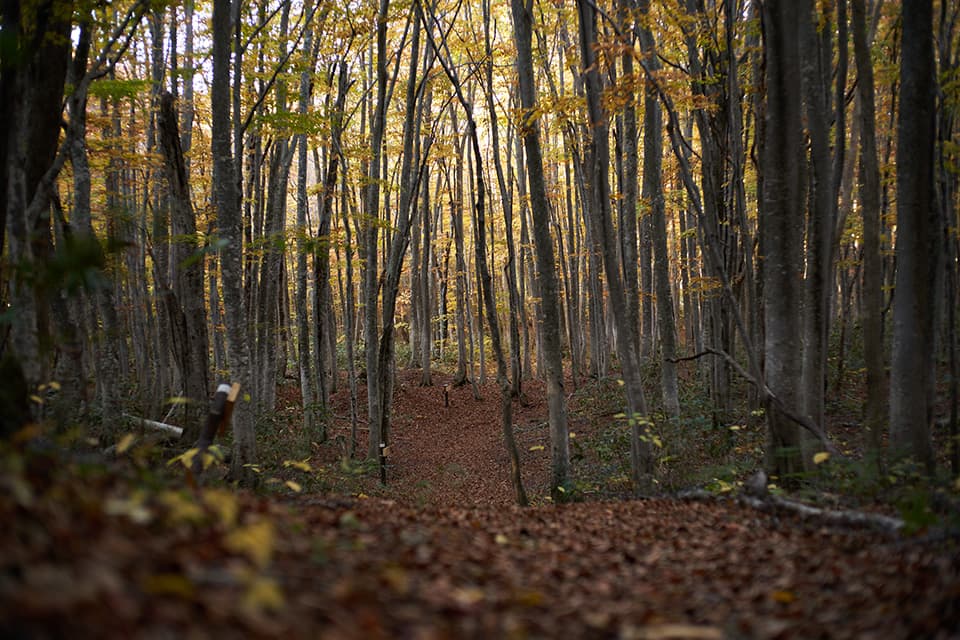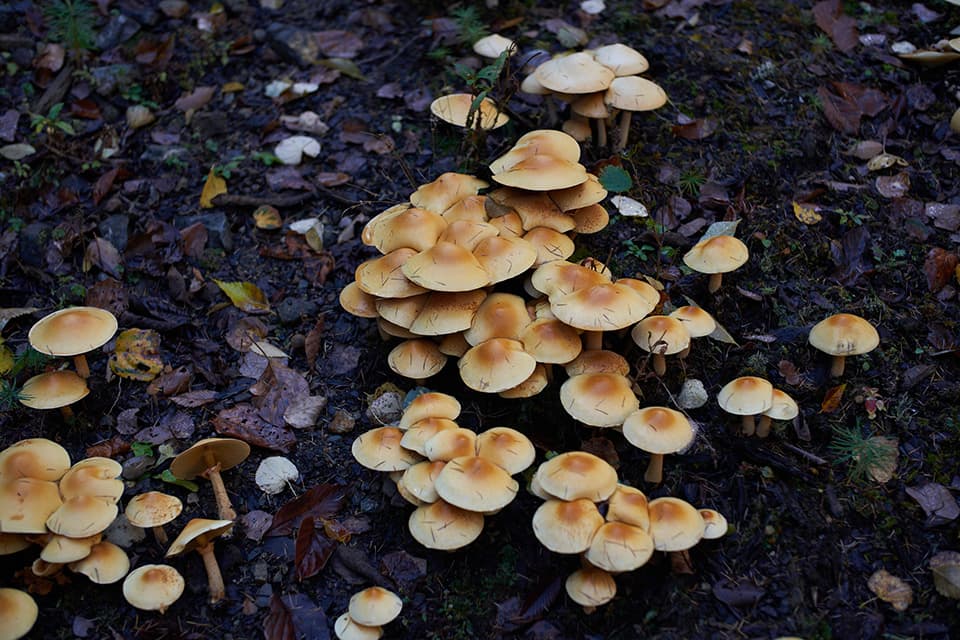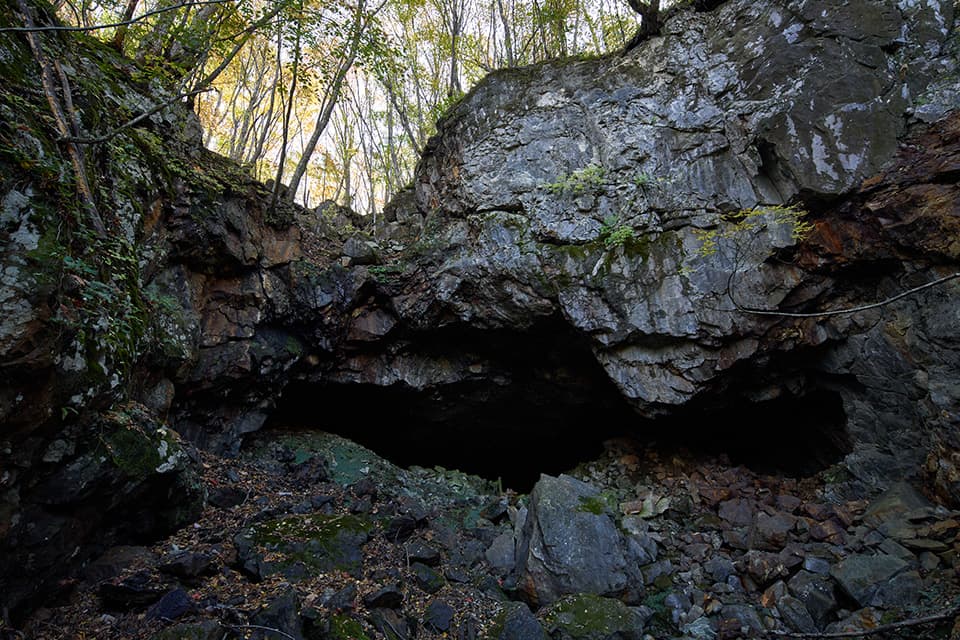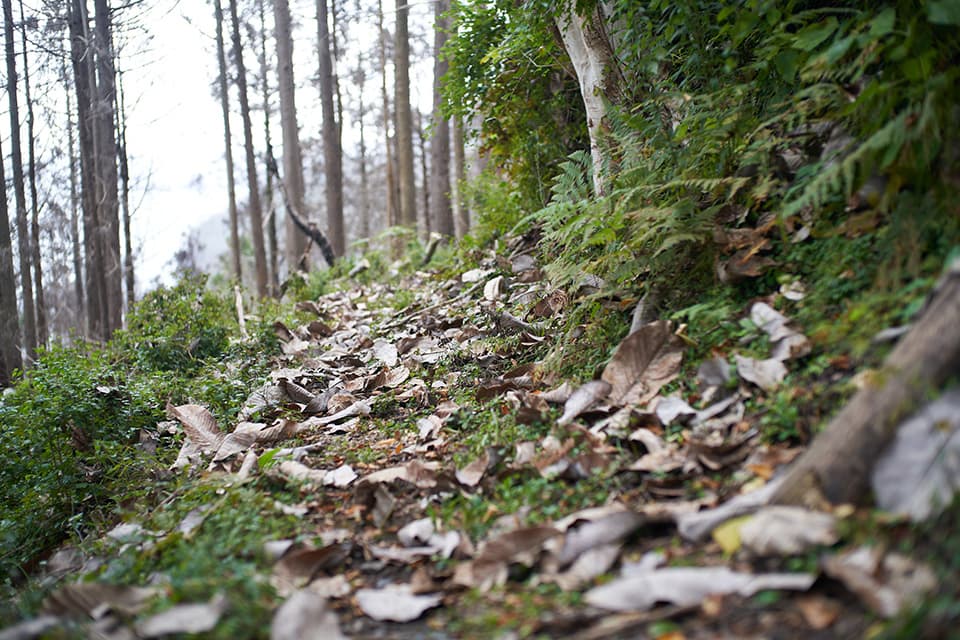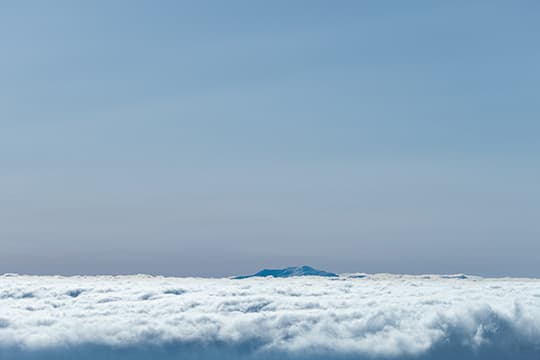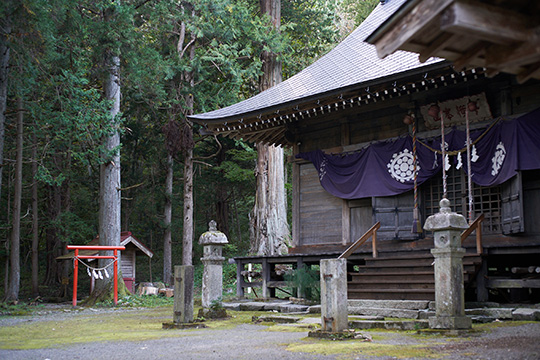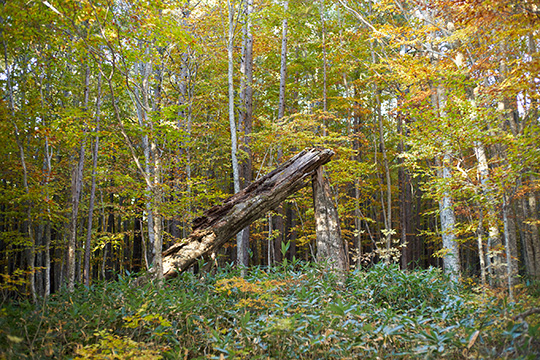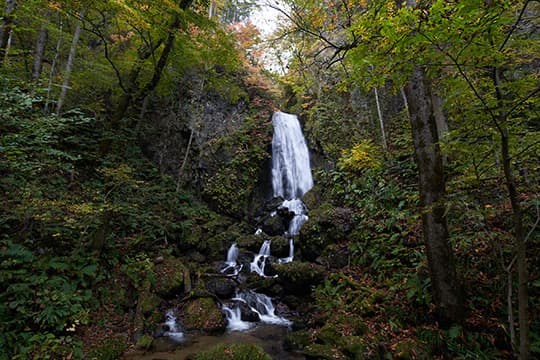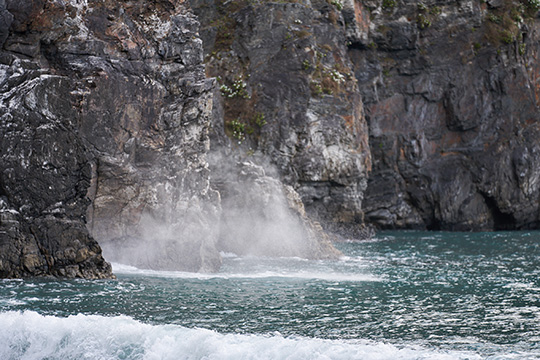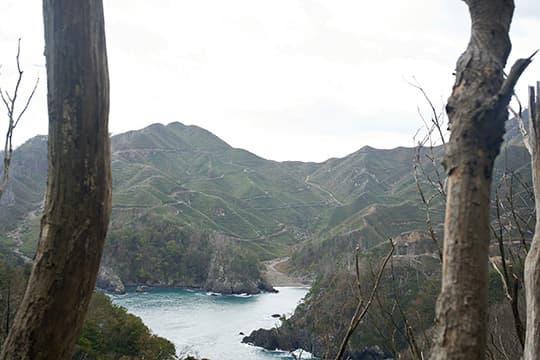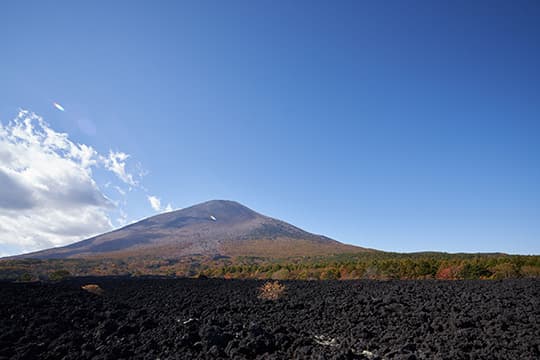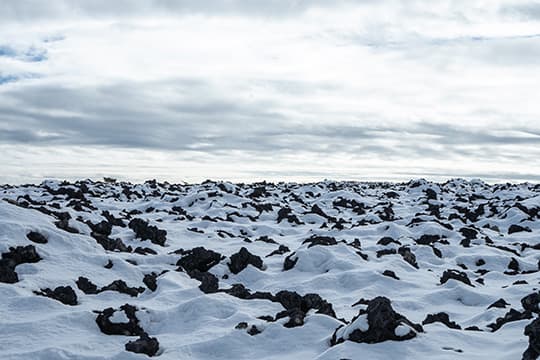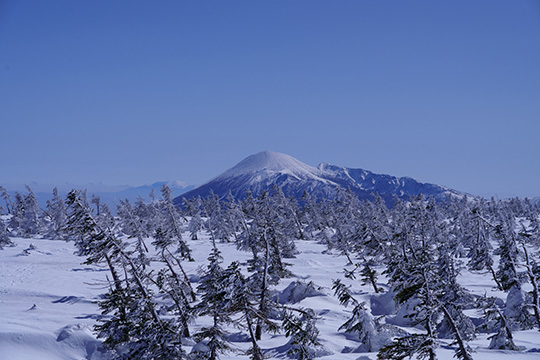To the west is the Ou Mountain Range, which is characterized by a row of volcanoes. In the Ou Mountains, there is Mt. Iwate, the highest peak in Iwate. It is thought that Mt. Iwate was born about 300,000 years ago, and it is a living volcano that has historically repeated eruptive activities from its birth to the present day. About 300 years ago, lava flowed out from Mt. Iwate and solidified, creating a very unique landscape. Despite such destruction caused by the Ou Mountains, many hot springs are also created due to the heat of the volcano, which gives blessings to the people living at the foot of the mountains.
To the east, the Kitakami Mountain Range, which cover two-thirds of the area of Iwate, magnificently extend toward the Pacific Ocean. Within the Kitakami Mountains, more than 60 of the mountains are over 1,000 meters high, with the highest being Mt. Hayachine. The Kitakami Mountains are made up of very old strata and in contrast to the Ou Mountains, they are no volcanoes. Furthermore, the Kitakami Mountains are blessed with resources such as iron and gold. Due to the abundance of iron sand and wood resources, it also has a history of conducting "tatara iron making”, which is where iron sand is reduced through the heat of combustion of charcoal in order to obtain iron.
The mountains of Iwate are covered with deciduous broad-leaved forests, and the main tree species are Mongolian oak, chestnut, oak, horse chestnut, walnut, maple, and beech. The blessings that deciduous broad-leaved forests offer are very diverse, including abundant nuts, wild plants and mushrooms, large mammals such as deer, boars and bears, and fish such as salmon and trout. Such blessings have helped to sustain the lives of the people of Iwate since the Jomon period, more than 10,000 years ago.
“Ocean”
The eastern side of Iwate Prefecture faces the Pacific Ocean, and the coastline known as the Sanriku Coast continues for a length of about 670 km.
The Sanriku coast has topographical differences between the northern and southern regions. The southern region has a submerged shoreline that is characteristic of a rias coast, and the northern region has a series of steep cliffs along the elevated coastline.
Off the Sanriku coast, the cold Chishima Current (Oyashio) southward from Hokkaido and the warm Japan Current (Kuroshio) moving northward in the Pacific Ocean collide to form a complex tide. Due to this phenomenon, this area has been known as one of the leading fishing grounds since ancient times. There are many fishing ports along the coast, and set net fishing is carried out at sea, while oysters, scallops, wakame seaweed, etc. are cultivated in the bay of the southern region.
The sea of Sanriku brought the blessings of abundant seafood to the people living there, but at the same time, it also brought great disaster.
On the Sanriku coast, large tsunamis have occurred periodically, destroying the towns located near the sea, and causing repeated catastrophes in which the lives and property of many people are lost in an instant. From modern times to the present time, the towns on the Sanriku coast have been hit four times by large tsunami.
However, despite such threats, the people of Iwate have lived with the sea for thousands of years since the Jomon period. Many ruins and shell mounds dating back to the Jomon period have been found on the Sanriku coast. In some cases, some of the areas are still inhabited by people today and the Jomon period remains are integrated in their lives.
“Beast”
Iwate, with its multiple deep mountains, is also a wild land that is home to the beasts. Various wild mammals live in Iwate and have been coexisting with humans since ancient times.
The black bear which stands at the top of the forest ecosystem, inhabits almost the entire area of Iwate and is one of the largest mammals in Japan. Sika deer, a large wild herbivore mammal living in the northern parts of the main island of Japan is also a particularly prosperous wild animal in Iwate. The Japanese serow, which is designated as a national special natural monument as an endemic species of Japan, also inhabits almost the entire area of Iwate. In addition, Japanese monkeys, Japanese wild boars, Japanese red foxes, Japanese raccoon dogs, Japanese badgers, Japanese marten, flying squirrels, Japanese squirrels, hares, etc. all inhabit this area.
In the past, Japanese wolves and Japanese river otters also lived there, but they have become extinct due to overfishing and extermination.
Since the Jomon period, these wild animals have been an indispensable blessing of nature for people living in Iwate, as they provided both meat and fur. However recently, these wild animals are often thought of as vermin that damage fields and livestock. Recently, as they have been making frequent appearances in human settlements and damaging crops, it has become a social problem. The question of how humans and beasts can coexistence is now increasingly asked.
Tour Information
#01
Snow Shoe Hiking
- Duration
- about3.5hours
- SEASON
- Winter
- LOCATION
- Hachimantai
- NB DAYS
- 1
- NB PERS
- 1-15
- Special features
-
- Snowshoe hikes through the snow-treading, silver-white world.
- There are beech or icefall courses where you can walk in the clear winter air.
- You can also observe the footprints of animals living in this area.
- Rental snowshoes included.
#02
Coastal Trail Trekking
- Duration
- about4hours
- SEASON
- All seasons
- LOCATION
- Kamaishi
- NB DAYS
- 1
- NB PERS
- 1-10
- Special features
-
- Enjoy the journey through the story of stones and humans to hear the voice of the earth, mediated by stones. That is, not about judging the past, but to find the implication for the future.
- Trek along the scenic Michinoku Coastal trail.
- Discover the breathtaking views as you can scramble over the imposing Senjojiki granite rock plateau.
- Difficulty: Easy short trail (3.2km each way).
#03
Mt.Hayachine Mountain Climbing
- Duration
- about6hours
- SEASON
- Summer
- LOCATION
- Tono
- NB DAYS
- 2
- NB PERS
- 1-10
- Special features
-
- This is a revived event that young people in the village went climbing to Mt.Hayachine to pray for the safety of the village.
- The 2nd highest sacred mountain in Iwate, Mt. Hayachine (1,917 m). It is a mountain that has been worshipped as a place of ascetic practices and an object of worship since ancient times.
- Before climbing a mountain, you can experience old customs such as offering kagura and making portable food for climbing.
#04
Forest Walk and Centering
- Duration
- about1day
- SEASON
- Spring-Autumn
- LOCATION
- Hachimantai
- NB DAYS
- 1
- NB PERS
- 1-10
- Special features
-
- A journey to reconnect with the sensors and antennas of your mind, body, and soul. Feel the life source within nature, that has continued throughout the generations within the natural environment, local people.
- We will guide you to the best spot of Hachimantai or the best spot where you can enjoy the coolness in the middle of summer according to the season and route.
- Yakehashiri Lava Flow is a 300 year-old magma trail found halfway up Iwate's highest active volcano. You experience the sky, the earth, and your existence as if you were on another planet.
- As you walk leisurely through beech forests and meadows, you can experience walking barefoot in the spring and lying on a bed of fallen leaves in the fall, immersing yourself in the sensations of the moment.
Inquiry & Reservation
We kindly ask you to fill out the contact form below for inquiries regarding availability, price, equipment, lodging and any other arrangements.



